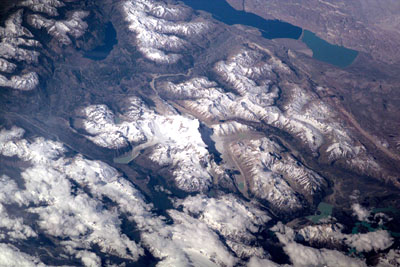Albedo
Click on image for full size
NASA Earth Observatory
This picture shows a part of the Earth surface as seen from the International Space Station high above the Earth. A perspective like this reminds us that there are lots of different things that cover the Earth. Soil, rocks, water, forests, snow, and sand - they all look different from above. They also have different ways of dealing with the solar energy that gets to our planet. Dark colored parts of the planet surface reflect very little of the solar energy that hits them. Light colored parts of the planet surface reflect almost all of the solar that hits them.
The amount of energy reflected by a surface is called albedo. Albedo is measured on a scale from zero to one (or sometimes as a percent).
- Very dark colors have an albedo close to zero (or close to 0%).
- Very light colors have an albedo close to one (or close to 100%).
Because much of the land surface and oceans are dark in color, they have a lower albedo and absorb a large amount of the solar energy that gets to them, reflecting only a small fraction of the energy. Forests have low albedo, near 0.15. The snow and ice, on the other hand, are very light in color. They have very high albedo, as high as 0.8 or 0.9, so they reflect most of the solar energy that gets to them, absorbing very little.
The combined effect of the albedo of all these surfaces is called the planetary albedo. Earth's planetary albedo is about 0.31. That means that about a third of the solar radiation that gets to Earth is reflected out to space and about two thirds is absorbed. The Moon's albedo is 0.07, meaning that only 7% of the energy that gets to it is reflected. The albedo of distant planets, so distant that they are difficult to study with telescopes, can be a very helpful to scientists trying to figure out what materials are at the planet surface. Something that absorbs all radiation would have an albedo of 0 and be called a black body.
Earth's climate is affected by the amount of solar radiation that is reflected back out to space and the amount of solar radiation that is absorbed. If Earth's climate is colder and there is more snow and ice on the planet, more solar radiation is reflected back out to space and the climate gets even cooler. On the other hand, when warming causes snow and ice to melt, darker colored Earth surface and ocean are exposed and less solar energy is reflected out to space causing even more warming. This is known as the ice-albedo feedback.
Clouds in Earth's atmosphere have an important effect on albedo, reflecting a large amount of solar energy out to space. While different types of clouds reflect different amounts of solar energy, their combined effect is huge. If there were no clouds in our atmosphere, Earth's average albedo, which is about 0.31, would drop by half.
Related links:
NSF News: Finding Answers in the Clouds
Changing Planet: Melting Glaciers Video and Classroom Activity
Changing Planet: Thawing Permafrost and Methane Video and Classroom Activity

